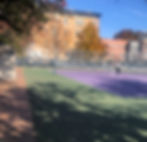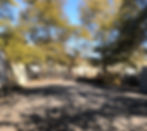A Tour of Resilient Infrastructure
- SWIM
- Nov 28, 2023
- 5 min read
By Shibani Debnath, SWIM Graduate Fellow
Green infrastructure allows New York City to adapt to climate change as a wetter climate is predicted in the future by New York City Panel on Climate Change (NPCC). Thus the time for expanding this resilient system has never been greater. Slowing down the movement of stormwater is essential to the city’s overall drainage, as a majority of New York City relies on combined sewer systems that have only been designed to handle rain events of 1.75 inches per hour. In this system, both raw sewage from homes and businesses and rainwater flow into the same pipes and when the system inevitably gets overwhelmed, the discharge overflows into the City’s waterways. With an overflow, harmful substances and pollutants from stormwater and sewage are not treated and are directly dumped into the City's waters. The image below illustrates the dry and wet weather conditions of combined sewer systems.

Image source: Open Sewer Atlas
In the last few months alone, New York City experienced nine consecutive weekends of rain, including Tropical Storm Ophelia in late September which flooded multiple areas across the city and inundated critical infrastructure like subway stations and roadways.
Flooding scenes from Tropical Storm Ophelia:
Image source: Flooded Bronx River Parkway drone footage from Hudson Valley News 12 (top left), Snapshots from Red Hook, and subway stations from the Daily Mail (top right and bottom images)
New York City is expected to experience higher frequency and intensity of storms in the future which will continue to challenge our current sewer systems, many of which are in need of upgrade and maintenance. Green infrastructure plays a critical role in addressing increased rains by constructing soil and vegetated areas for stormwater to be stored, slowed down and diverted away from the sewers. Additionally, green infrastructure can provide co-benefits like reducing the impact of urban heat island effect, and improving air quality.
See NYC's current Green Infrastructure Assets installed by DEP in the interactive map linked here.

Image source: NYC DEP
Last month, the NYC Soil and Water Conservation District hosted a green infrastructure bus tour that highlighted a few green infrastructure assets in Brooklyn from site-scale solutions like permeable pavement options to large-scale solutions like designated naturalized flooding areas.

The first stop was the tennis courts in Jackie Robinson Park Playground in Bed-Stuy, Brooklyn. This part of the neighborhood is situated in a priority combined sewer overflow (CSO) area. Retrofitting green infrastructure with recreation space is a great way to combine multiple uses in a dense urban environment. These tennis courts in particular have been designed to incorporate subsurface detention that can handle approximately 1.2 million gallons of stormwater annually. Even in excessive rainfall events in the last few months, this area successfully managed all stormwater without any reports of overflow. This project was recently completed in coordination with NYC Department of Environmental Protection (DEP) and NYC Department of Parks and Recreation, and its performance with rain events is being monitored as additional assets like the one above are being considered in other priority CSO areas. The tennis courts could not be surfaced with permeable pavers because the courts are used for official tournaments and as such, they need to be built to strict regulations. DEP staff informed us that tennis balls bounce differently on permeable pavers (who knew?). This was another little backstory that illustrates the challenges in green infrastructure retro fitting.

Our second stop was the rain garden installed on the sidewalk adjacent to Brevoort NYCHA housing. This particular rain garden was one of the first iteration of rain gardens designed by DEP, with one curb cut for stormwater flow along with installation of native plants and grasses. Even though this is a small site scale intervention occupying only 32 square feet of space, it has been designed to handle about 2,000 gallons of stormwater. Updated rain garden designs have two curb cuts for improved stormwater flow, as well as an observation well, a perforated pipe, to monitor rain garden performance. Depending on the space and weather conditions, a rain garden in the city can also include shrubs and trees along with grasses. Rain gardens are an excellent opportunity to incorporate resilient infrastructure in a small space as it does not interrupt road or pedestrian traffic. These small gardens can also attract pollinators depending on planting species, and are usually low maintenance. However, these spaces are often the first to get littered, which reduces its capability in managing stormwater. Next time you go out for a walk, take a moment to see your local street tree pits to notice if that is a designated rain garden. And if you think a tree pit should become a rain garden or are interested to learn more on this intervention, contact DEP on their website here.

Our third stop was the porous parking lot in the Brevoort NYCHA Complex that is currently under construction. Porous pavement options like permeable pavers and porous concrete are becoming a popular solution to incorporate stormwater management while maintaining other land uses. While porous pavement is appropriate for parking lots, it is important to consider that these solutions often do not offer co-benefits, and there may be a risk of groundwater contamination as it is typically not designed to filter chemicals and pollutants that may be released from parking lots.
Next we went to East Flatbush, where we had a chance to see a FloodNet sensor in action. FloodNet is a team of researchers, educators, and students that study real-time rain data and monitor flood levels through infrared sensors. Through data analysis on high tide flooding, stormwater runoff and stormwater surge, the team at FloodNet aims to provide communities with data to reduce flood risk. There are about 75 sensors currently installed over the city, but there are plans to expand this system to 500 sensors in the near future.
Our last stop was Paerdegat Basin Ecology Park between Canarsie and Bergen beach. This 5-acre site is a saltwater wetland that has been restored. This space provides coastal protection as a designated flood zone filled with native plants including several varieties of Pine and Oak trees, Spartina and Little Blue-Stem grasses, Beach Plum and Buttonbush shrubs and more varieties that allow for a diverse ecosystem of species. Softening the city’s edge with techniques that mimic the historic wetlands of New York is essential in protecting coastal communities.
An expansive and connected green infrastructure system can mimic the filtration capacity of wetlands creating a sponge effect that retains and slowly releases water. Nature-based solutions like green infrastructure are a step towards improved stormwater management and water quality as they decelerate water and divert it from combined sewer systems. It is also important to consider New York City’s historic landscape consisted of a system of marshes, wetlands, mudflats, bogs, and peats connected through a network of streams. Since the city was built above a rich wetland ecosystem, even on dry days there are instances of sunny-day flooding (chronic tidal flooding) that is amplified with sea level rise. The solution to NYC’s flooding is not just green infrastructure, however, it should be considered a part of a larger system including parks, open spaces, sewer and water infrastructure that are critical in adapting New York City to a wetter climate.

















